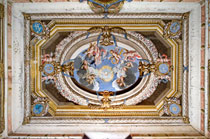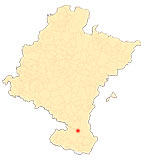Sanctuary of Nuestra Señora del Yugo
Introduction
A large typological group within the religious architecture of the centuries of the Baroque in Navarre are the sanctuaries generally dedicated to the Virgin that were remodelled or rebuilt for different reasons in numerous towns in the Ribera region of Tudela or Estella and, in general, outside the town centre. In plan, most of them follow the rigid patterns of convent architecture with simple Latin crosses and domes in their transepts. They are usually made of brick with small chapels added in the 18th century and their silhouettes sometimes break up monotonous landscapes. Almost all those from the 16th century (Yugo de Arguedas, Esperanza de Valtierra, Romero de Cascante, Purísima de Cintruénigo or Remedios de Sesma) and those from the following century (Soto de Caparroso, Mendigaña de Azcona) are subject to this model . The great exception is the basilica of the Virgen del sponsorship in Milagro, a building designed in 1699 by Pedro Aguirre with an original centralised plan that is typically Baroque and which enhances the personality of its author.
All of them were authentic signs of the identity of the towns and villages, although some, due to their importance, transcended the towns in whose jurisdiction they were located, as in the case of that of the Yugo. The cult of the Virgin, disdained in northern Europe, had its counterpart in the south of the continent and in Baroque Spain in particular, with all these local Marian devotions or those of each religious order, not forgetting the Immaculate Conception, which became a social and cultural phenomenon that went beyond the strictly religious.
-
MUNÁRRIZ, L., El santuario del Yugo, Pamplona, Imprenta y Librería de Joaquín Lorda, 1898.
-
GARCÍA GAÍNZA, M. C. and others, Catalog Monumental de Navarra. I. Merindad de Tudela, Pamplona, Government of Navarre-Archbishopric of Pamplona-University of Navarre, 1980.
-
FERNÁNDEZ-LADREDA, C., Imaginería medieval mariana, Pamplona, Government of Navarre, 1989.
-
FERNÁNDEZ GRACIA, R., "Un aspecto de la arquitectura barroca en Navarra: los camarines", conference proceedings del I congress General de Historia de Navarra. Príncipe de Viana (1988), appendix 11, pp. 149-158.
-
ECHEVERRÍA GOÑI, P. and FERNÁNDEZ GRACIA, R., "La arquitectura religiosa de los siglos XVI al XVIII en Navarra", Ibaiak eta Haranak. Guía del Patrimonio artístico y paisajístico. Navarra, vol. VIII, San Sebastián, Etor, 1991.
-
AZANZA LÓPEZ, J. J., Arquitectura Religiosa Barroca en Navarra, Pamplona, Government of Navarre, 1996.
-
FERNÁNDEZ GRACIA, R., The Baroque altarpiece in Navarre. Pamplona, Government of Navarre, 2003.












